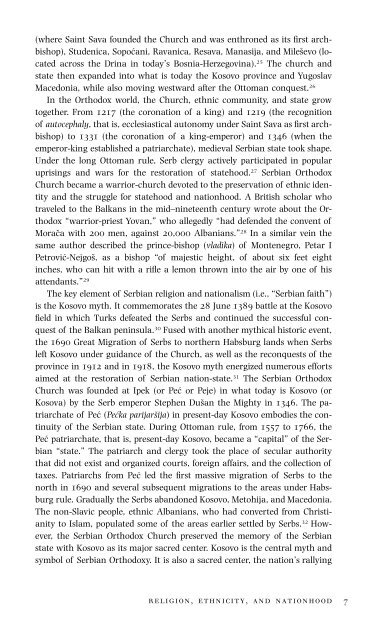Balkan Idols: Religion and Nationalism in Yugoslav States
Balkan Idols: Religion and Nationalism in Yugoslav States
Balkan Idols: Religion and Nationalism in Yugoslav States
You also want an ePaper? Increase the reach of your titles
YUMPU automatically turns print PDFs into web optimized ePapers that Google loves.
(where Sa<strong>in</strong>t Sava founded the Church <strong>and</strong> was enthroned as its first archbishop),<br />
Studenica, Sopoćani, Ravanica, Resava, Manasija, <strong>and</strong> Milesˇevo (located<br />
across the Dr<strong>in</strong>a <strong>in</strong> today’s Bosnia-Herzegov<strong>in</strong>a). 25 The church <strong>and</strong><br />
state then exp<strong>and</strong>ed <strong>in</strong>to what is today the Kosovo prov<strong>in</strong>ce <strong>and</strong> <strong>Yugoslav</strong><br />
Macedonia, while also mov<strong>in</strong>g westward after the Ottoman conquest. 26<br />
In the Orthodox world, the Church, ethnic community, <strong>and</strong> state grow<br />
together. From 1217 (the coronation of a k<strong>in</strong>g) <strong>and</strong> 1219 (the recognition<br />
of autocephaly, that is, ecclesiastical autonomy under Sa<strong>in</strong>t Sava as first archbishop)<br />
to 1331 (the coronation of a k<strong>in</strong>g-emperor) <strong>and</strong> 1346 (when the<br />
emperor-k<strong>in</strong>g established a patriarchate), medieval Serbian state took shape.<br />
Under the long Ottoman rule, Serb clergy actively participated <strong>in</strong> popular<br />
upris<strong>in</strong>gs <strong>and</strong> wars for the restoration of statehood. 27 Serbian Orthodox<br />
Church became a warrior-church devoted to the preservation of ethnic identity<br />
<strong>and</strong> the struggle for statehood <strong>and</strong> nationhood. A British scholar who<br />
traveled to the <strong>Balkan</strong>s <strong>in</strong> the mid–n<strong>in</strong>eteenth century wrote about the Orthodox<br />
“warrior-priest Yovan,” who allegedly “had defended the convent of<br />
Morača with 200 men, aga<strong>in</strong>st 20,000 Albanians.” 28 In a similar ve<strong>in</strong> the<br />
same author described the pr<strong>in</strong>ce-bishop (vladika) of Montenegro, Petar I<br />
Petrović-Nejgosˇ, as a bishop “of majestic height, of about six feet eight<br />
<strong>in</strong>ches, who can hit with a rifle a lemon thrown <strong>in</strong>to the air by one of his<br />
attendants.” 29<br />
The key element of Serbian religion <strong>and</strong> nationalism (i.e., “Serbian faith”)<br />
is the Kosovo myth. It commemorates the 28 June 1389 battle at the Kosovo<br />
field <strong>in</strong> which Turks defeated the Serbs <strong>and</strong> cont<strong>in</strong>ued the successful conquest<br />
of the <strong>Balkan</strong> pen<strong>in</strong>sula. 30 Fused with another mythical historic event,<br />
the 1690 Great Migration of Serbs to northern Habsburg l<strong>and</strong>s when Serbs<br />
left Kosovo under guidance of the Church, as well as the reconquests of the<br />
prov<strong>in</strong>ce <strong>in</strong> 1912 <strong>and</strong> <strong>in</strong> 1918, the Kosovo myth energized numerous efforts<br />
aimed at the restoration of Serbian nation-state. 31 The Serbian Orthodox<br />
Church was founded at Ipek (or Peć or Peje) <strong>in</strong> what today is Kosovo (or<br />
Kosova) by the Serb emperor Stephen Dusˇan the Mighty <strong>in</strong> 1346. The patriarchate<br />
of Peć (Pećka parijarsˇija) <strong>in</strong> present-day Kosovo embodies the cont<strong>in</strong>uity<br />
of the Serbian state. Dur<strong>in</strong>g Ottoman rule, from 1557 to 1766, the<br />
Peć patriarchate, that is, present-day Kosovo, became a “capital” of the Serbian<br />
“state.” The patriarch <strong>and</strong> clergy took the place of secular authority<br />
that did not exist <strong>and</strong> organized courts, foreign affairs, <strong>and</strong> the collection of<br />
taxes. Patriarchs from Peć led the first massive migration of Serbs to the<br />
north <strong>in</strong> 1690 <strong>and</strong> several subsequent migrations to the areas under Habsburg<br />
rule. Gradually the Serbs ab<strong>and</strong>oned Kosovo, Metohija, <strong>and</strong> Macedonia.<br />
The non-Slavic people, ethnic Albanians, who had converted from Christianity<br />
to Islam, populated some of the areas earlier settled by Serbs. 32 However,<br />
the Serbian Orthodox Church preserved the memory of the Serbian<br />
state with Kosovo as its major sacred center. Kosovo is the central myth <strong>and</strong><br />
symbol of Serbian Orthodoxy. It is also a sacred center, the nation’s rally<strong>in</strong>g<br />
religion, ethnicity, <strong>and</strong> nationhood 7


